Inspired Steps
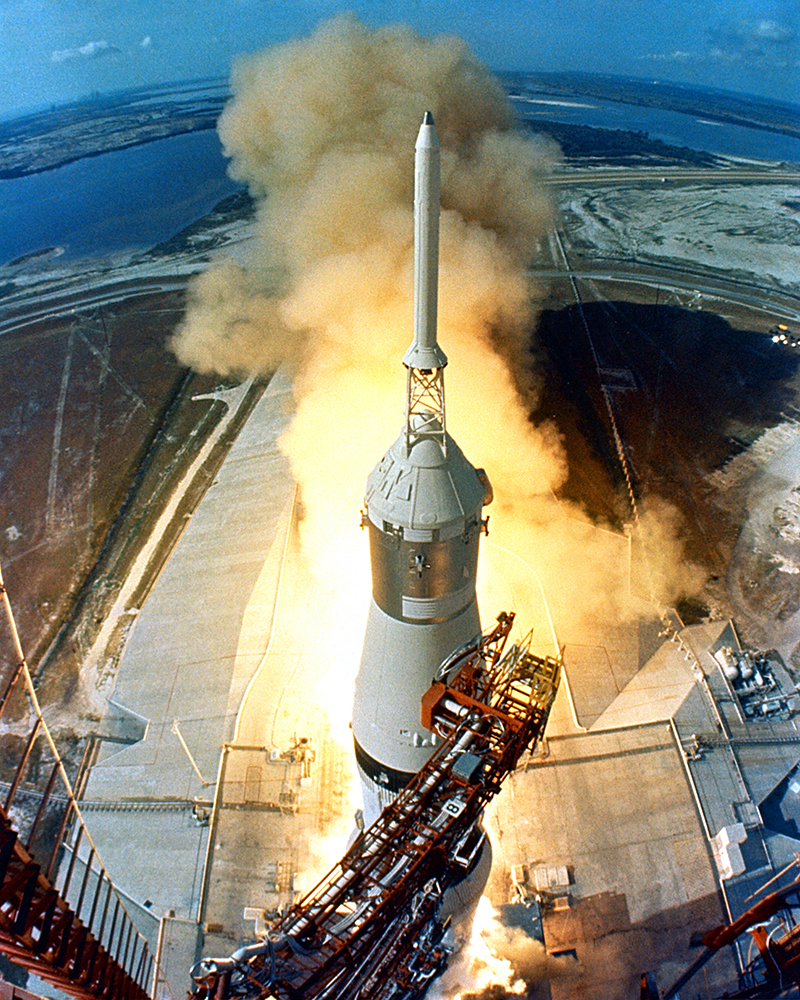
A plume of flame signals the liftoff of the Apollo 11 Saturn V space vehicle and astronauts Buzz Aldrin, Neil Armstrong, and Michael Collins from Kennedy Space Center. (Photo by NASA)
Montclair’s Buzz Aldrin and the Apollo 11 Mission
By Donald H. Sanborn III
July 20 will mark the 50th anniversary of the day that Apollo 11 astronauts Neil Armstrong and Montclair, New Jersey, native Dr. Buzz Aldrin walked on the moon. Despite the recent films First Man and Apollo 11; the character of Buzz Lightyear from Disney’s Toy Story series, named after Aldrin; and a commemorative coin launched by the U.S. Mint; some question the extent to which the milestone is remembered today.
“Knowledge of the moon landing has kind of receded into the past, and people are unaware that we were actually a very active space-faring nation back in the 1960s,” says William Murray, the planetarium technician for the New Jersey State Museum. The museum now presents “Many Inspired Steps,” a retrospective of the moon landing.
Jacob Brandt, a composer and lyricist who conceived the song cycle, 1969: The Second Man, remarks that “Aldrin was just as integral to that mission as Neil Armstrong. There were hundreds of thousands of people working to make the moon landing happen. But in our collective memory we think of Armstrong first, even though he stepped on the moon minutes before Aldrin did. We don’t often think of Aldrin.”
Still, in 2015 Montclair’s Mount Hebron Middle School, which Aldrin attended, was renamed for him. The change is the result of a successful campaign led by the Man on the Moon Committee, spearheaded by Montclair resident Katie Rubacky Severance.
“I … can remember gazing over at the house he grew up in, on Princeton Place, and just marveling that someone who lived there went to the exact same schools I did, and ended up walking on the moon,” Severance tells Baristanet in 2015. “It’s been a mystery to me … why one of the schools he attended is not named in his honor.”
Daniel Taylor, a teacher at Buzz Aldrin Middle School, has spoken to a few people who remember the Apollo 11 mission. “They said it was incredible — the pride that they felt — knowing that someone from their community, who went to school with them, accomplished that feat. They were emotional when they spoke about it, as if it had just happened,” says Taylor, who nevertheless agrees with Murray and Brandt. “I don’t get a sense that the moon landing is something that people often talk about; it’s not prevalent.”
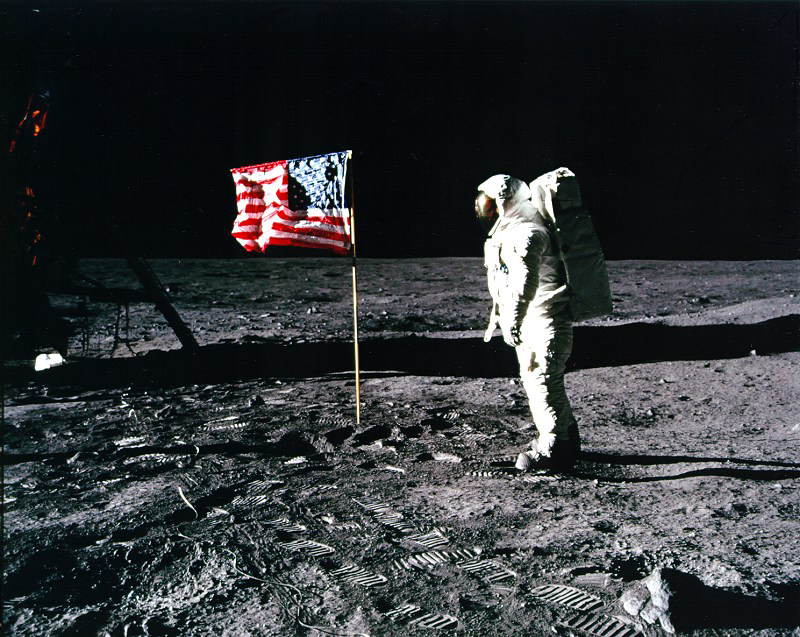
Buzz Aldrin regards the flag he and his crewmates placed on the moon. (Photo by NASA)
Countdown
Dr. Aldrin was born in Montclair on January 20, 1930. Although he was named Edwin Eugene Aldrin, Jr. after his father, who also was an aviator, the younger Aldrin legally changed his name to Buzz “for the convenience and clarity,” he quips in No Dream Is Too High (National Geographic Partners, 2016). He remembers that his sister Fay Ann, two years his senior, “had difficulty pronouncing ‘brother,’ so she called me ‘Buzzer.’” Aldrin’s mother’s maiden name was Marion Moon.
Aldrin played center for the Montclair High football team, which won the New Jersey state championship in 1946. A special edition of Life magazine that was published shortly after the moon landing notes that “not surprisingly, considering his father’s example, Buzz decided that he wanted to be an aviator, which meant trying for an appointment to West Point or Annapolis.” He graduated from West Point in 1951, third in his class.
Upon entering the Air Force in 1952, Aldrin was assigned to the 16th Fighter-Interceptor Squadron. His service in Korea earned him two Distinguished Flying Crosses and three Air Medals.
Through the Air Force Institute of Technology, he enrolled as a graduate student at MIT in 1959; in 1963, he earned a Sc.D. degree in astronautics. His doctoral thesis, “Line-of-Sight Guidance Techniques for Manned Orbital Rendezvous,” is “dedicated to the crew members of this country’s present and future manned space programs. If only I could join them in their exciting endeavors!”
Jim Zarrilli is a paraprofessional who has worked in the Montclair Public Schools district for 16 years, the last 14 of which he has worked at Buzz Aldrin. He works as an aide, helping special needs children. He remembers, “When I was a senior at Montclair High School in 1966, Aldrin came and talked in the auditorium. This was three and a half years before the moon landing, before he was really on the map. He had not reached the height of what he was about to do. He talked about growing up in Montclair, and how he was involved in the NASA program — which hopefully, one day, would put a man on the moon.”
In 1962 Aldrin applied to join NASA’s Astronaut Group 2, but was rejected because he was not a test pilot. However, in 1963 NASA changed the requirements to include pilots who had at least 1,000 hours flying time in jet aircraft, and Aldrin had logged 2,200 hours flying in jets. He was selected for Astronaut Group 3, becoming the first astronaut to hold a doctoral degree.
NASA launched Gemini 12, the last manned Gemini flight, in 1966. It was commanded by James A. Lovell, who later was part of the Apollo 8 and Apollo 13 missions. Aldrin’s extra-vehicular activities included installing electrical connectors, testing tools, and taking photographs. During a space walk Aldrin took a photo of himself in which the Earth is behind him.
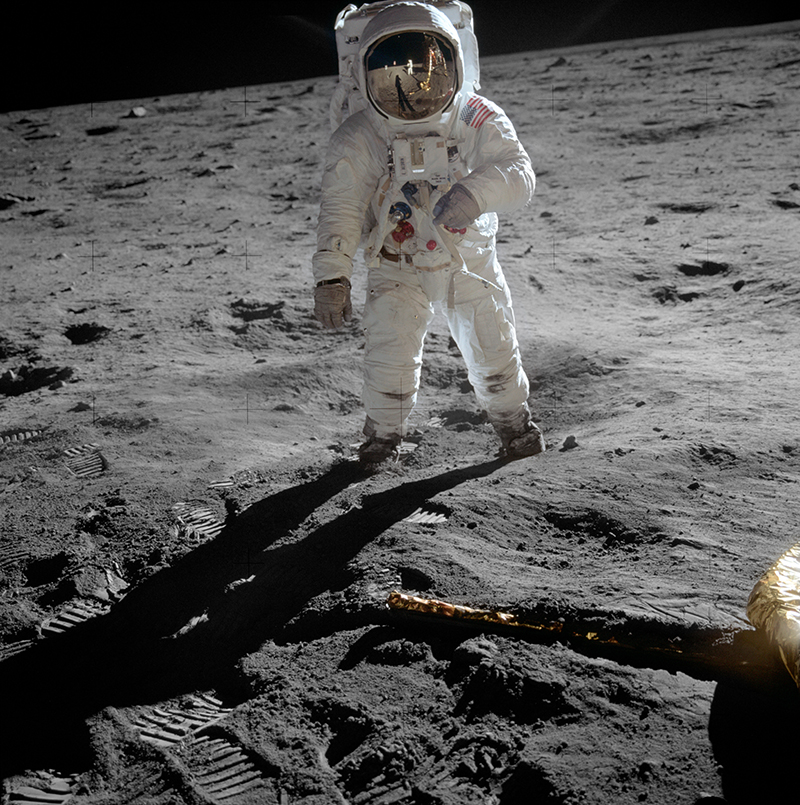 5
5
“The Eagle Has Landed”
Commanded by Armstrong, Apollo 11 launched on July 16, 1969 at 9:32 a.m. Aldrin, who was the mission’s lunar module pilot, previously had worked with Armstrong when they were part of the backup crew for Apollo 8. Michael Collins piloted the command module, Columbia.
On July 20 Armstrong and Aldrin entered the lunar module, the Eagle. “Landing was the hardest part,” Aldrin remembers in No Dream Is Too High. “Our planned landing site was filled with large boulders surrounding a crater that Neil estimated to be more than a hundred feet wide, with steep slopes, so we continued maneuvering the Eagle … when we finally touched down, we had only 15 to 20 seconds of fuel remaining!” Nevertheless, Armstrong radioed Houston, “Tranquility Base here. The Eagle has landed.”
Two and a half hours after landing, Aldrin broadcast these remarks: “This is the LM pilot. I’d like to take this opportunity to ask every person listening in, whoever and wherever they may be, to pause for a moment and contemplate the events of the past few hours and to give thanks in his or her own way.”
In front of the TV camera, and with considerable difficulty posed by the hard surface, Armstrong and Aldrin planted a United States flag, which Aldrin saluted. They also left a plaque which reads, “Here men from the planet Earth first set foot upon the moon. We came in peace for all mankind.”
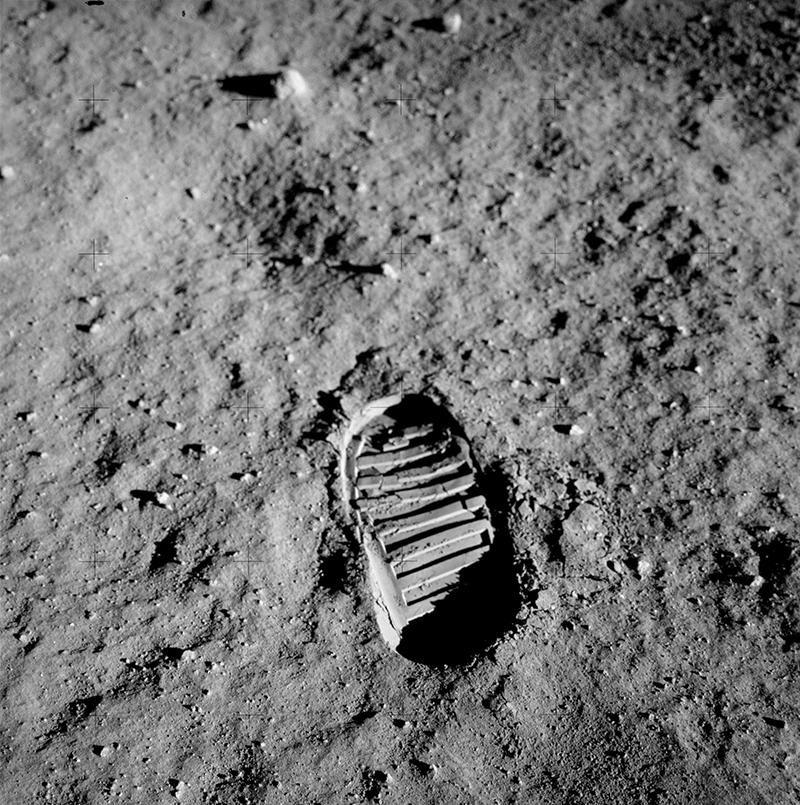
‘’Apollo 11’’ Lunar Module Pilot Buzz Aldrin’s bootprint. Aldrin photographed this bootprint about an hour into their Lunar Extra-vehicular activity on July 20, 1969 as part of investigations into the soil mechanics of the lunar surface. (Photo by NASA)
“Many Inspired Steps”
Presented by the New Jersey State Museum, “Many Inspired Steps” is presented at the Riverside Gallery through November 10. Thomas A. Lesser has organized and donated the exhibition, which is “a photographic retrospective on not only the Apollo 11 moon landing, but all of the space programs that led up to it, as well as some of the space missions after Apollo 11,” says Murray.
“The main photographic part of the exhibit is from NASA,” Murray continues. “It’s a traveling exhibit … a retrospective of Apollo moon landing. We’re also doing a special new planetarium show — CAPCOM Go! — about the Apollo 11 moon landing, to go with the exhibit.”
The web page for the exhibition promises that it will “emphasize New Jersey’s connection to this historic event.” Murray explains, “There are some artifacts in the exhibit that were created by New Jersey firms for the space program.” Of Aldrin, Murray says, “It’s noted that he was a New Jersey native; we have a large mock-up of his famous picture on the moon.” Murray hopes that the retrospective will increase viewers’ “appreciation of where we were in the 1960s, and hopefully get us started on further exploration of space in the future.”
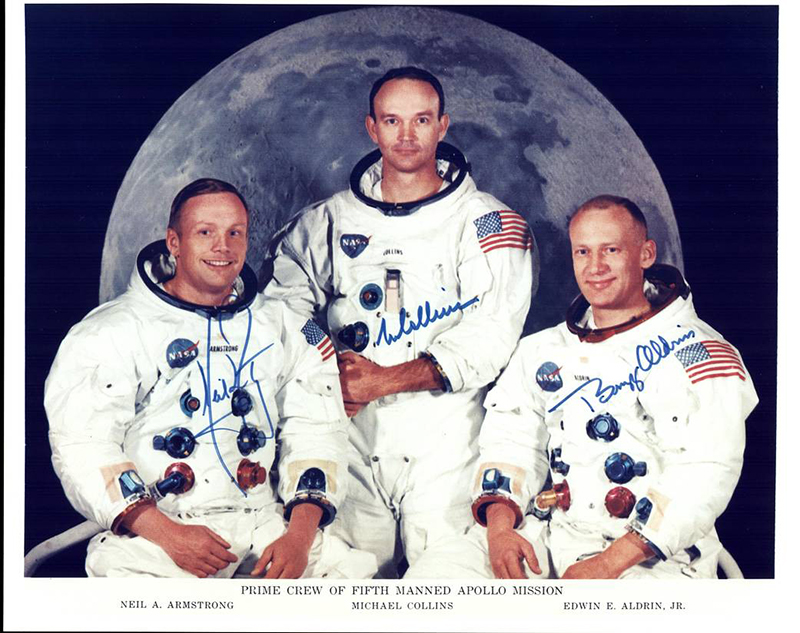
“Right After First”
In an episode of The Simpsons, Homer asks Aldrin how it feels to be the second person to walk on the moon. Aldrin retorts that “Second comes right after first.”
However, in No Dream Is Too High Aldrin admits, “For years, I bristled at my notoriety, being known as ‘the second man on the moon.’” He adds that he would have been first — “the commander normally stayed with the spacecraft while the junior officer … left the spacecraft to perform the EVAs” — had NASA not changed its procedures prior to the Apollo 11 launch.
Brandt reflects that “I believe that it may have felt painful to be the second man rather than the first man. In 1969: The Second Man, I imagine what that might have felt like, to be something great but want something more.” Brandt wrote the song cycle with playwright Dan Giles. Directed by Jaki Bradley, the show premiered at the New York Theatre Workshop in August 2018.
“Using the moon landing as a mythic event, I was curious to explore what kind of toll the drive toward exceptionalism can take on a person,” Brandt continues. “I’m a musician and composer, as well as a performer, and I love folk music, so I thought, what better way to tell a grand adventure story than through folk music? The show is performed by a band of actor-musicians who loosely take on characters throughout the story, but it presents itself in the form of a concert.”
Homecoming
“To achieve something so great as to be one of the first men on the moon, and have to return to Earth — figuratively and literally — must be an immense challenge, one to which very few people can relate,” Brandt observes. “That kind of isolation must have been difficult; nobody could really understand what he’d been through, because few others had been through it.”
“Six weeks after Aldrin landed on the moon, there was a parade for him in Montclair, around Labor Day weekend, in September 1969,” Zarrilli remembers. “There’s a picture of him in a convertible, waving to some people. I was so disappointed at the time, since I had to go back to college a few days before the parade. A lot of my friends were there and told me how exciting it was.”
Dr. Jill Sack, the principal of Buzz Aldrin Middle School, adds, “A banner from the parade is hanging in our school office.”
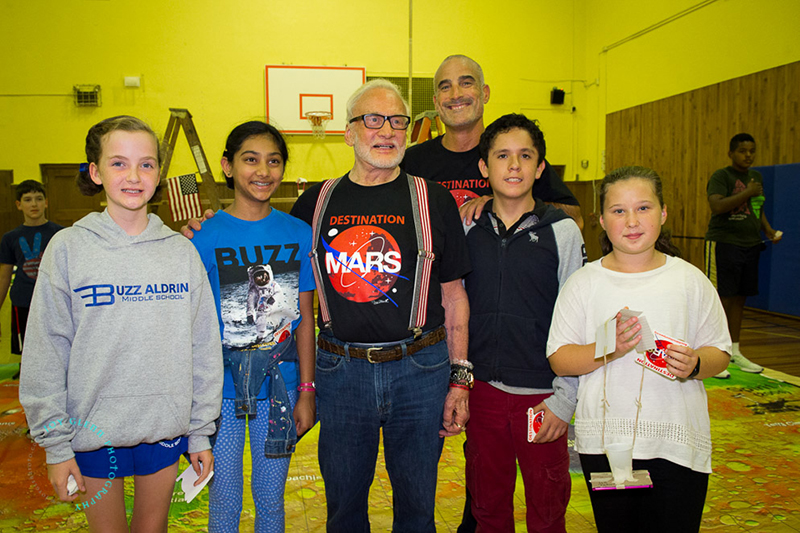
From left: Liliane Braun-Arnold, Shonita Srinivasan, Buzz Aldrin, Daniel Taylor, Kaleb Hurtado De Mendoza, and Dana Oscar. The students pictured were finalists in Buzz Aldrin Middle School’s Engineering Design Challenge. Aldrin attended the finals to be the primary judge for the finals and spend time with a few of the students. (Photo by Joy Glenn)
Buzz Aldrin Middle School
Aldrin visited his former middle school on October 27, 2015. “We toured him around the school, and he talked to some kids,” Sack remembers. “This was during the time when the Board of Education was still considering the name change.”
“He came back in September 2016 for a dedication ceremony,” Sack continues. “We had dignitaries, the mayor, the Essex County freeholder, Town Council members, and Board of Education members. We had a drum corps play. It was a dedication to the district’s most famous alumnus. It was a special day for us, and I think it was a special day for him. I think he was touched by all the fanfare and excitement around the dedication. When he talked to the kids, he spoke about his memories of going to the school.”
Aldrin’s website notes that he “has been a life-long advocate of STEM.” Fittingly, the school that bears his name has a STEM focus. “In our district, there are seven elementary schools, three middle schools, and one high school,” Taylor explains. “Each of the elementary and middle schools has a magnet theme. As long as I’ve been here, our school has been the science and technology magnet; about seven years ago they redefined it as the STEM magnet, to add engineering and math.”
“We just started a stargazing event in the fall of 2018,” Taylor continues. “It was open to the community and held in association with the New Jersey Astronomical Group (NJAG). We are in discussions with NJAG to have monthly or biweekly stargazing events here at our school, so that the community can enjoy looking at the moon and deep space objects, as well as planets. We plan to hold future stargazing evenings next year.”
Sack says that Buzz Aldrin is an inspiration to the students. “There’s a bust of Aldrin sitting in our lobby,” she says. “The kids know that he was educated in this building, and his education in the STEM fields inspired him. This is what he talked about when he was here; he was a student in this school when he decided that those were his areas of interest. That helped to launch him in the direction of NASA, and then to the moon. How can you not be inspired by that?”
Comments ( 1 )
The comments are now closed.


[…] “Inspired Steps: Montclair’s Buzz Aldrin and the Apollo 11 Mission” was published in the Summer 2019 issue of Urban Agenda Magazine. In honor of the fiftieth anniversary of the moon landing, I interviewed William Murray, the planetarium technician for the New Jersey State Museum, which is presenting a commemorative exhibit, “Many Inspired Steps,” through November 10. I also talked to Jacob Brandt, the composer and lyricist of a song cycle, 1969: The Second Man; and educators from Buzz Aldrin Middle School in Montclair. […]